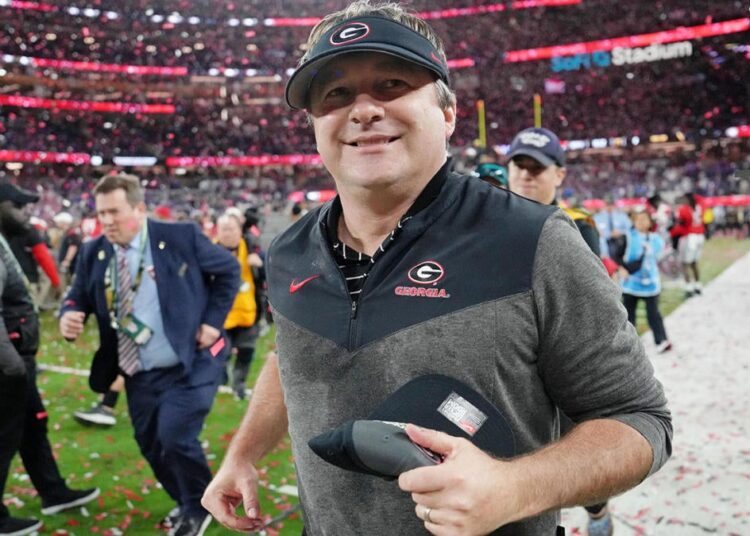How much does it cost to buy the resources necessary to win a national championship? If you ask the two-time reigning champion Georgia Bulldogs, the answer is $16,518,859. The Bulldogs spent that much between 2017-22 on recruiting expenses, which was more than $5 million more than any other program in the country over the same period, according to analysis of public records obtained by USA Today. The gap between Georgia and No. 2 spender Alabama almost matches the difference between Alabama and Nebraska.
Recruiting budgets can cover a wide variety of expenses during the process, including vast recruiting departments, transportation, visits and much more. While spending does not guarantee success, seven of the last eight titles were won by schools in the top three in recruiting spending: Georgia, Alabama and Clemson.
It’s worth noting there was a downswing in spending in 2021 — for obvious reasons. The pandemic severely limited recruiting expenses, but it bounced back in a major way in 2022 with record spending across the board. Additionally, schools compile these numbers differently, which impacts comparison. Still, the bottom-line number gives us a baseline comparison.
Private schools were not included in USA Today’s analysis as they are not subject to records requests. Additionally, data could not be found for Pittsburgh, which is not subject to FOIA requests under Pennsylvania law.
ACC
|
Clemson |
$3,158,941 |
$1,661,691 |
|
North Carolina |
$1,306,117 |
$856,072 |
|
Georgia Tech |
$1,240,706 |
$763,426 |
|
Louisville |
$1,019,027 |
$659,819 |
|
Virginia |
$994,851 |
$641,396 |
|
Florida State |
$899,308 |
$1,257,758 |
|
Virginia Tech |
$898,675 |
$623,166 |
|
NC State |
$632,696 |
$538,879 |
If you want to be the best, you have to spend like the best. Clemson more than doubles any other ACC program in recruiting spending and trails only Georgia among all programs nationally. That’s translated to the No. 5 Talent Composite team in the country, the only public ACC team in the top 15. North Carolina’s investment under Mack Brown also deserves serious credit.
To the contrary, Florida State’s recruiting spending is embarrassing, ranking in the bottom half of the Power Five and behind schools like Texas Tech, California and Virginia. FSU has put together strong classes under Mike Norvell, but it’s no wonder the staff has doubled down on the transfer portal. NC State also shocks by ranking bottom five in the Power Five despite a 47-28 record over the same period.
Big Ten
|
Michigan |
$2,240,064 |
$1,353,431 |
|
Rutgers |
$1,609,032 |
$879,494 |
|
Penn State |
$1,486,521 |
$1,240,848 |
|
Maryland |
$1,380,974 |
$683,200 |
|
Ohio State |
$1,292,799 |
$845,113 |
|
Illinois |
$1,157,460 |
$749,850 |
|
Minnesota |
$1,127,389 |
$904,139 |
|
Nebraska |
$1,020,050 |
$937,279 |
|
Michigan State |
$955,303 |
$721,879 |
| Purdue | $878,651 | $602,360 |
| Wisconsin | $857,490 | $392,724 |
| Indiana | $826,713 | $606,147 |
| Iowa | $577,589 | $459,128 |
It’s little surprise that Jim Harbaugh puts so much emphasis on recruiting at Michigan, which has helped spur back-to-back Big Ten championships. From a results perspective, though, Ohio State might have the most efficient recruiting process in the country. The Buckeyes were 21st in spending over the past five years and have numerous top-five classes with recruits from around the country to show for it.
Elsewhere, it’s easy to see why Wisconsin felt it had to go in a new direction. The Badgers had the lowest recruiting spending in the nation under Paul Chryst over the past five seasons, ranking as the only team to average fewer than $400,000 per season in spending. Expect that number to balloon past $1 million with Luke Fickell now taking the program into the 21st Century.
Big 12
|
Oklahoma |
$2,632,817 |
$1,301,044 |
|
Texas |
$2,439,774 |
$1,301,044 |
|
West Virginia |
$971,286 |
$620,286 |
|
Texas Tech |
$930,264 |
$670,002 |
|
Kansas |
$846,411 |
$751,073 |
|
Kansas State |
$841,640 |
$604,447 |
|
Iowa State |
$804,942 |
$775,494 |
|
Oklahoma State |
$455,689 |
$473,500 |
Unsurprisingly, Texas and Oklahoma lap the rest of the league in recruiting expenses and have the top 10 classes to show for it. The gap between the rest of the league is vast, though it’s worth noting that TCU and Baylor, typically the next two most successful recruiting programs in the league, do not have data available. Texas Tech beefed up its recruiting infrastructure significantly as Joey McGuire took over the program.
The recruiting budget perfectly lays out why the West Virginia job is so difficult. The Mountaineers need to spend nearly $1 million to simply hold serve in the Big 12 with a number of top recruits coming from Florida and Georgia, a lengthy plane ride from Morgantown. Oklahoma State had the lowest recruiting budget in the Power Five in 2022 but still managed to sign solid classes. Is it a credit to Mike Gundy’s relationships or a worrying harbinger of things to come? It’s hard to tell.
Pac-12
|
Oregon |
$1,836,865 |
$1,027,045 |
|
Washington |
$1,464,753 |
$733,140 |
|
Arizona |
$1,312,678 |
$679,765 |
|
Utah |
$1,152,211 |
$873,088 |
|
California |
$1,041,868 |
$619,171 |
|
Oregon State |
$1,008,117 |
$727,442 |
|
UCLA |
$899,099 |
$673,583 |
|
Colorado |
$770,283 |
$569,888 |
|
Washington State |
$641,614 |
$449,554 |
|
Arizona State |
$461,196 |
$461,366 |
Oregon and Washington naturally hold the top two spots on the list by a wide margin, but the next tier is more interesting. Arizona’s spending exploded under new coach Jedd Fisch as the Wildcats put together one of the best recruiting classes in recent memory. To the contrary, Arizona State’s recruiting budget tanked under Herm Edwards as the Sun Devils faced NCAA violations for improper recruiting tactics during the pandemic.
Colorado is near the bottom of the list, but expect that number to rise dramatically as the Buffaloes get rolling under new coach Deion Sanders. California’s number was surprisingly high — more than Nebraska and Florida State — despite having few results to show for it. Utah has built a robust-yet-cost-effective system to capture the last two Pac-12 championships.
SEC
|
Georgia |
$4,506,248 |
$2,753,143 |
|
Texas A&M |
$2,984,168 |
$1,567,746 |
|
Tennessee |
$2,918,691 |
$1,788,183 |
|
Alabama |
$2,324,470 |
$1,912,050 |
|
Florida |
$1,641,320 |
$1,073,676 |
|
Auburn |
$1,307,480 |
$859,271 |
|
Ole Miss |
$1,269,391 |
$671,713 |
|
Arkansas |
$1,220,882 |
$1,098,022 |
|
Missouri |
$1,215,934 |
$699,049 |
|
South Carolina |
$1,102,357 |
$773,304 |
|
Kentucky |
$917,657 |
$703,094 |
| LSU | $742,713 | $982,769 |
|
Mississippi State |
$633,482 |
$406,701 |
Naturally, SEC recruiting spending is off the charts. Four of the top five spenders nationally over the past five years are in the conference with Georgia, Alabama and Tennessee leading the way. Texas A&M forced its way into the conversation by spending nearly $3 million during the 2022 cycle, nearly triple its number from 2020.
After moderate spending in the past several years on probation, Ole Miss exploded under Lane Kiffin. LSU is surprisingly low on the list, but it’s also likely a testament to the level of talent within driving distance of Baton Rouge. Ten of the 15 members of LSU’s 2022 recruiting class were from the state, while two others were from Texas.
Read the full article here


























